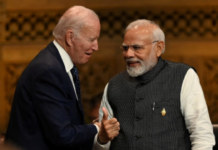NEW DELHI: The US has more than 20 lakh Covid-19 confirmed cases, and it is the only country, which has recorded the highest daily growth of positive cases so far. June is proving to be the worst month for India, in its fight against Covid-19, as a threatening trend of over 10,000 Coronavirus cases has set in. India has more than 3.3 Lakh cases so far. In the world tally, India is at the fourth position after it reached the grim milestone of 3 lakh with 10 days of recording 2 lakh on June 3. It had taken four and a half month for its first lakh cases.
“I would not be surprised if India surpasses the US in the total number of cases by the end of the pandemic,” said Manisha Juthani, an infectious diseases specialist and associate professor of medicine and epidemiology at Yale School of Medicine. She added it seems the number of cases will continue to rise by the end of 2020 in India.
Q: Currently, India is witnessing over 10,000 Covid-19 cases daily, and many experts say peak is yet to come. A peak will be reached and then its decline to baseline, do you think India will surpass the US, during this period, which has more than 20 lakh confirmed cases?
A: I believe that testing for Covid-19 in slums in India is likely very limited. If this is true, whatever cases India has is likely an underestimate. Looking at the curve in India, it is only going up so hard to know when it will start to go down. Given that lockdown has been eased and based on the sheer population of people in India’s big cities, it is very likely that many more will get infected. Hence, I would not be surprised if India surpasses the US in the total number of cases by the end of the pandemic.
But if India doesn’t have wide-scale testing, we won’t know for sure. The only way to guess would be to look at the average number of deaths on a usual yearly basis and compare that to the number of deaths that are actually occurring.
Q: India has already relaxed the nationwide lockdown. Barring containment zones, life has bounced back to normal. In the absence of a vaccine, what do you think will happen in India by 2020 end, will the cases continue to grow rapidly?
A: The number of cases in India is continuing to rise. India is one of 68 countries that are continuing to rise. The curve appeared to flatten a bit likely during the lockdown; however, the steep of the curve has sharpened, consistent with the reopening. I do anticipate that the number of cases will continue to rise by the end of 2020 in India. The rate at which cases occur could slow if people wear masks, keep distance, and wash hands. Particularly those that have the capacity to maintain distance should try to do so as much as possible. Without further lockdown, testing, and contact tracing, I do not know when the curve might start to go down. Likely that would not happen until there is enough herd immunity (60-70 per cent of the population is infected).
Q: Being a specialist in infectious diseases, do you think the lockdown worked for India, and it will help in reaping dividends in the overall strategy of India against Covid-19 spread?
A: Lockdown likely did help many segments of the population. Those who were infected and could stay isolated at home may have transmitted to other family members but prevented spread to other communities. However, all measures need to be done given the contexts of local communities. Without helping to control the virus in impoverished neighborhoods, it will continue to circulate there because lockdown is very difficult in some areas where there is no stable housing and ability to isolate. As people need to work, bring help into the home, get back on buses and trains, the virus which is still circulating will continue to spread.
Q: Reports say the production and distribution of Covid-19 vaccine will begin by the end of 2021. For these 18 months, what do you suggest to the vulnerable group – elderly and people with comorbidities, how can they safeguard themselves against this deadly viral infection?
A: There are reports that some vaccines might even be available by the end of 2020. Older adults and those with comorbidities need to be extra careful. If they have bungalows outside of the big cities or can retreat to a hill station, this might be a good place to go so that you can get fresh air and go outside. In big cities, going outside can be very risky right now with the congestion of people. If you are extremely anxious, please just stay at home. It is certainly risky to go out and engage in your usual activities right now. Become more tech savvy and try to stay in touch with relatives with video conferencing.
Q: It is said that pandemics jump from animals to humans. Chinese have been consuming various kinds of animal meat for many years. Why did this jump occur from animals to humans late in 2019, was there a specific event?
A: We don’t know the answer to that yet. At this point, the science suggests that this virus came from bats. It likely made a jump from bats to humans sometime in late 2019, likely because of some association between people and bats. At this point, it seems that an infected person, or maybe several infected people, might have gone to the Wuhan market which then led to the first identified large outbreak. It doesn’t seem that the virus originated in that market at this time. This virus has an incredible ability to spread among people who are close to each other, not wearing masks, even during the pre-symptomatic period. For these reasons, it was able to spread in China. Because of worldwide travel, infected people went all over the world, and borders to travelers were not closed for a long time in many countries so the virus continued to spread. It is remarkable how the virus has taken over the world in such a short period of time.
Q: WHO said the spread of coronavirus by ‘asymptomatic’ is less likely? What do you have to say on this?
A: We need to see the data that the WHO referenced to know for sure. It appears from their statements that those that never have any symptom whatsoever, not even atypical symptoms like Covid toes or diarrhea, seem to be less likely to transmit the virus to others. When asymptomatic people are identified, and when they trace their contacts, many of those contacts were not infected. People who are pre-symptomatic (eventually go on to have symptoms) are highly infectious. People wouldn’t know if someone is asymptomatic or pre-symptomatic which is why we have to wear masks.







